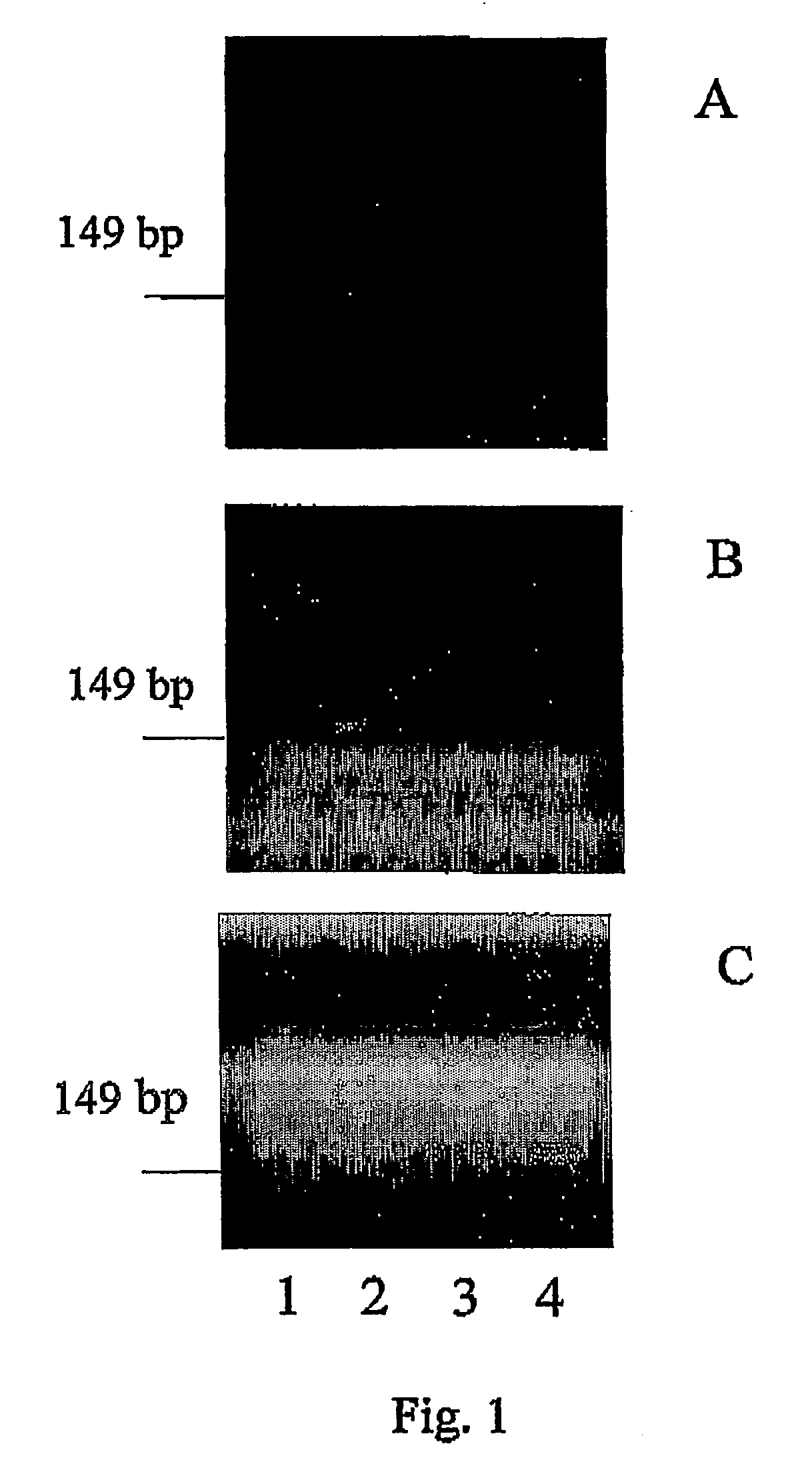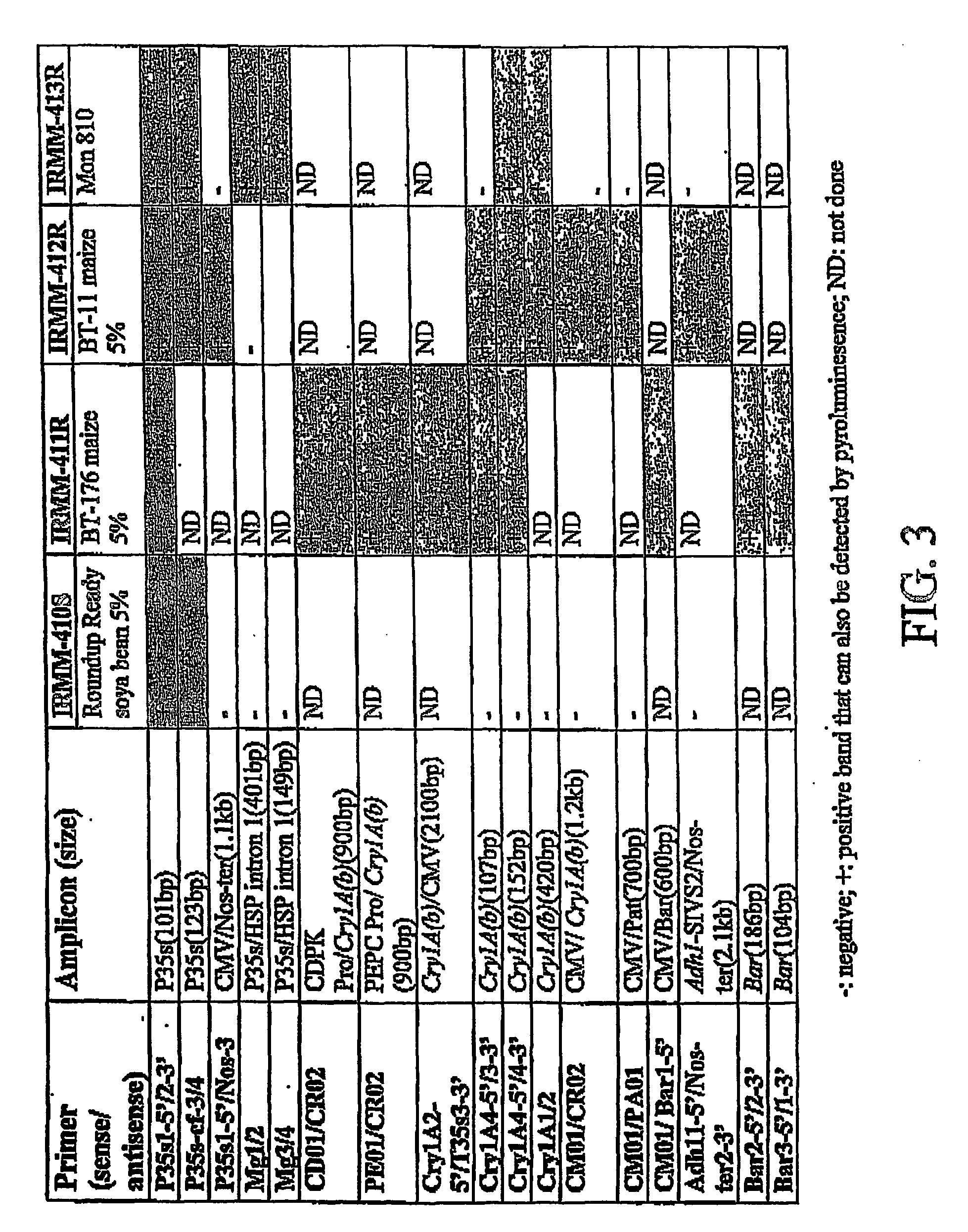Detection of transgenes of genetically modified organisms using pyro luminescence
a technology detection methods, applied in the field of detection of genetically modified organisms transgenes using pyro luminescence, can solve the problems of inability to achieve real-time measurement, large number of fluorescent complexes, and large methods, and achieve the effect of facilitating polymerase-directed replication of target sequences
- Summary
- Abstract
- Description
- Claims
- Application Information
AI Technical Summary
Benefits of technology
Problems solved by technology
Method used
Image
Examples
example 1
Detection of the Event Specific Target Nucleic Acid of MON810 Maize
[0046] Reference samples of maize containing the transgenic GMO corn line MON810 were obtained from Sigma Aldrich Chemical Company. Genomic DNA was isolated from the maize sample using the High Pure GMO sample preparation kit available from Roche Diagnostics Corporation of Indianapolis, Ind. A pair of event specific primers, MG3:5′-agt atc ctt cgc aag acc ctt cct c-3′(SEQ ID NO. 1) and MG4:5′-gca ttc aga gaa acg tgg cag taa c-3′(SEQ ID NO. 2) were used to amplify a 149 basepair fragment of the transgene corresponding to the region of the junction of 35S promoter and HSP intron 1 of MON810 maize.
[0047] PCR REACTION: PCR was performed using the PTC-100 thermal cycler (available from MJ Research, Inc). The reaction was carried out in a total volume of 30 μl and contained 0.2 μl of each of the primers MG3 and MG4, 0.25 mM of each of the four dNTPs (dATP, dCTP, dGTP, dTTP), 1.5 mM MgCl2, 1.5 units of Taq DNA polymerase ...
example 2
[0057] Plant material obtained from Sigma Aldrich Chemical Company containing 5% Roundup Ready Soybeans, 5% Bt 176 maize and 5% Bt-11 maize have been analyzed for the presence of the specific transgenes which provide the insect resistance and herbicide resistance traits to commercial plant lines having these specific traits using the methods described in Example 1. The results of these detection and amplification experiments are present in FIG. 3. The sequences of the primer pairs used in the assays are given in Table 1 below. The results of these experiments demonstrate the general applicability of the methods of the present application to the identification of a variety of different target nucleic acid sequences in a sample to be analyzed for small amounts of those target sequences
TABLE 1PrimerSequenceP35S1-5 / 2-35′ att gat gtg ata tct cca ctg acg t 3′SEQ ID NO. 35′ cct ctc caa atg aaa tga act tcc t 3′SEQ ID NO. 4P35S-cf-3 / 45′ cca cgt ctt caa agc aag tgg 3′SEQ ID NO. 55′ tcc tct ...
PUM
| Property | Measurement | Unit |
|---|---|---|
| temperature | aaaaa | aaaaa |
| temperature | aaaaa | aaaaa |
| temperature | aaaaa | aaaaa |
Abstract
Description
Claims
Application Information
 Login to View More
Login to View More - R&D
- Intellectual Property
- Life Sciences
- Materials
- Tech Scout
- Unparalleled Data Quality
- Higher Quality Content
- 60% Fewer Hallucinations
Browse by: Latest US Patents, China's latest patents, Technical Efficacy Thesaurus, Application Domain, Technology Topic, Popular Technical Reports.
© 2025 PatSnap. All rights reserved.Legal|Privacy policy|Modern Slavery Act Transparency Statement|Sitemap|About US| Contact US: help@patsnap.com



